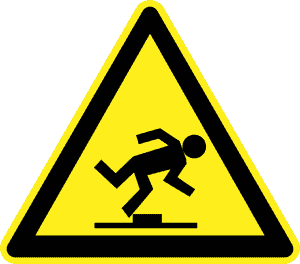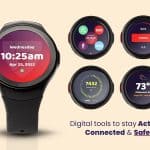Falls are a leading cause of injuries in people over 65, and if you fall into this category, it’s important to take steps to keep yourself safe. In the past, traditional safety pendants have been the most prevalent form of fall detection for older adults. However, the pendant with only a button isn’t a perfect solution for dealing with falls. Luckily, many companies are leveraging digital technology to offer more comfortable and reliable solutions for detecting falls. The devices are also becoming more and more affordable. You can compare Life Alert costs on our site.
Advice for Seniors
The Centers for Disease Control and Prevention notes that 1 in every 4 seniors will fall this year, making for hundreds of thousands of injuries and unplanned hospital visits. This number, though, is expected to be much higher as seniors often fall and do not report it to their loved ones or their physician. The CDC notes that senior falls are indeed a public health concern, projecting 52 million falls annually by the year 2030.
Fortunately, there are steps that seniors and their loved ones can take to decrease the risk of falling. Seniors can work on their balance, strength, and endurance through consistent exercise as well as adapting their home to include grab bars and other fall-prevention additions. Another way to prevent falls? Incorporating the use of fall detection technology.
What is fall detection and why is it important?
Falling is much more dangerous for seniors than it is for younger people. This is because older adults are at a much higher risk of injury. Older adults are more susceptible to osteoporosis, which can make their bones more fragile and likely to break. Falls can also cause serious head injuries or even death in extreme cases.
You’re also much more likely to fall when you get older. There are a few reasons for this. Many seniors experience fatigue as a result of chronic health conditions or medications they take. This can affect motor skills and make walking more difficult. It’s also common for your eyesight to deteriorate as you get older, which makes it harder to avoid potential obstacles. Finally, many seniors have health conditions that affect muscle and neurological function, such as Alzheimer’s or Parkinson’s, which can make you more likely to fall.
Fall detection and prevention are extremely important for keeping seniors healthy and safe. Fall detection technologies are used to identify when a senior has fallen and send medical assistance to them right away. Fall prevention reduces the chance of a fall happening in the first place.
How does automatic fall detection work?
When you think of a fall alert system, you are likely to think of a pendant that seniors can wear around their neck and push when they have fallen. A push of the pendant’s button directs the senior to a monitoring center representative who can take their information and get them the help they need. However, what happens when the senior falls and loses consciousness, making it impossible to push their button for help?
Thanks to modern assistive technology, automatic fall detection now offers peace of mind to seniors and family members. Automatic fall detection technology uses a variety of sensors, including accelerometers and processors, to determine when someone has fallen. This technology is typically built into existing watches, pendants, or other devices. When the sensors detect a potential fall, the system alerts the emergency response call center who will check in with the user to determine if there is a need to send a first responder to the situation.
Available for In-Home and Mobile GPS Systems
Automatic fall detection technology has come a long way in the past decade. Now, seniors and their caregivers have a variety of options when it comes to making automatic fall detection technology a part of their lives. Depending on your loved one’s lifestyle, preferences, and fall history, you can look into options that include GPS components as well as in-home options.
The latest in-home systems use sensors throughout the home to detect falls, typical routine, and even potential illnesses. Systems from Cherry Home and Aloe Care Health use technology to notify designated family caregivers, as well as call center representatives, in case of fall or other emergency. Even better, systems are designed to maintain privacy and do not require users to wear a pendant or other device while inside the home.
For seniors on the go, look for a device that offers automatic fall detection as well as GPS tracking capability. This can be especially helpful if your loved one falls while out and about or if they are unsure where they are when talking with emergency responders at the call center. The GPS feature also allows designated family members to know where their loved ones are, which can be especially helpful for seniors who run, hike, or bike long distances.
Do I need auto fall detection?
Auto fall detection is a wonderful addition to the medical alert system landscape. Automatic fall detection might benefit you or your loved one if you or they have:
- Fallen in the past six months
- A history of low blood pressure or lightheadedness
- A history of stroke or sudden confusion
- A medical history that includes diagnoses like diabetes, Parkinson’s, or dementia
- A recommendation from a physician or medical specialist
- Anxiety about being at home alone or not having easy access to emergency assistance
Auto Fall Detection is Not for Everyone
While automatic fall detection benefits many older adults and offers peace of mind to their loved ones, it might not be for you. If you are relatively healthy, with no history of falls or medical conditions that can increase your fall risk, you might not want to use a device that features automatic fall detection.
Beyond the Wrist: What are the downsides of the traditional pendant?
Pendants, where you have to manually press a button, have been the most common form of “fall detection” for several decades; although they don’t really detect a fall. These systems are sometimes referred to as personal emergency response systems or PERS devices. These devices are worn around the neck and have a button that seniors can press to alert emergency responders that they are in need of help. Some modern PERS devices can automatically detect when a senior has fallen, so they do not need to press the button.
One of the biggest downsides of using a traditional pendant is that there is a stigma that comes with wearing one. Many seniors don’t want to alert others to the fact that they are scared of falling or at a higher risk of injury. With pendants that have buttons, there’s always the risk that the user won’t be able to press the button. Even automatic detection systems aren’t always accurate, which can leave a senior without help after a dangerous fall or even cause false alarms. Additionally, pendants only track falls after they happen – they don’t provide any prevention technology.
Modern Fall Detection Solutions
There are a few different technologies that have come out in the past decade that provide an alternative to a pendant. These technology options are a great way for seniors to keep themselves safe. Here are some of the most exciting fall detection solutions to hit the market.
Smart Watches: The Apple Watch added a fall detection feature to their product starting with series 4, which was released in 2019. Since then, we’ve seen other brands like Samsung add fall detection features to their line of smart watches. Smart watches have accelerometers and gyroscopes, which makes them an ideal technology to use for fall detection.
In Apple’s case, the watch asks users their age during the setup process, and will automatically turn on the fall detection feature for anyone over the age of 55. When the watch detects a fall, it displays a notification on screen. The user can dismiss the notification if it is a false alarm, but in the event of an actual fall, the watch will automatically call emergency responders and send your location to them.
In addition to these mainstream smart watches, there are also smartwatches available that are designed specifically for seniors but don’t typically have fall detection built-in. An example would be the Freedom Guardian. Although these senior smartwatches are simpler and easier to use than a traditional smartwatch, they currently don’t have fall detection sensors built-in. They do though have features like text messaging as well as biometric tools for tracking blood pressure, heart rate, and sleep cycles.
Smart watches are a very accurate way to track things like movement, speed, and biometrics, plus they’re very discreet. This discreetness makes them a great solution for seniors who want to wear a fall detector, but may be self-conscious about wearing a pendant. Many popular smart watches even come with a variety of options for bands and faces, so you can customize them to suit your style.
Fall Detection Apps: While many smart watches are adding built-in fall detection programs, there are also downloadable apps with advanced features that you can also use for this purpose. These apps are available for smartphones as well as smart watches. Many of these apps do require a membership fee and also leverage voice detection software, so you can get help simply by telling your device that you fell. They also allow you to call a trusted friend or family member for minor falls instead of calling 911.
Whole Room Wall Sensors: Another advanced technology for fall detection is a wall sensor. While these products are still in development, they can provide a good alternative to wearable devices and can be placed in spaces like the bathroom or kitchen where falls are most likely to happen. These sensors can use camera-based sensors or radar imaging to monitor for sudden movements that could be indicative of a fall.
These are just a few of the emerging technologies that could change the way we detect falls. In the future, we can expect to see technology grow further to prevent these falls from happening in the first place. For a long time, pendants were the only tool we had for helping with falls, but now we can go further to ensure that seniors get the help they need right away.
The Apple Watch
The Apple Watch 4 was the first smartwatch to incorporate automatic fall detection into its list of features. Versions that followed, including 5 and 6, continued to incorporate the automatic fall detection technology.
Studies conducted by Apple report that the watch was able to successfully detect a fall 12 out of 15 times, which is outstanding. Even better, the watch sends an alert to the user that allows them to request help or cancel the request within 60 seconds. If there is no response, the watch contacts emergency assistance on the user’s behalf, along with coordinates for the user’s location.
For tech savvy seniors who are looking for a stylish way to ensure more safety, the Apple Watch is an excellent choice.
FallCall Solutions
FallCall Solutions offers a variety of app based fall detection solutions. Users can download any of their app options for the Apple Watch, iPhone, or Android device. Depending on the type of app selected for the device, users can benefit from different types of fall detection, emergency response, and communication options.
The FallCall® Detect option pairs strictly with Apple Watch and can detect high and low impact falls, which can make the e emergency response even more effective.
Lifeline Personal Alert Systems with AutoAlert
Philips Lifeline, a well known company within the medical alert industry, also offers a fall detection option for their system. AutoAlert offers automatic fall detection technology and is built into many of their pendants and systems.
From Fall Detection to Fall Prevention
Automatic fall detection leverages technology in order to keep users as safe as possible and to get them the emergency response they need efficiently. However, the ideal situation is to not fall at all in the first place. You can work with your loved one and their physician to implement environmental and lifestyle changes that can prevent falling.
Some automatic fall detection technology can add to preventative measures. Some home-based sensor systems, as well as some wearable systems, record and monitor heart rate, blood pressure, and gait patterns, which can help to alert family members of potential problems so they can help to solve them before a fall occurs.



